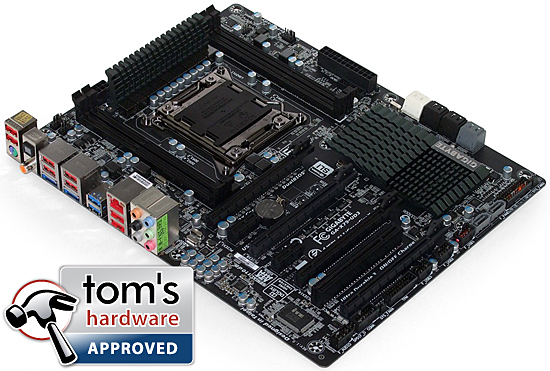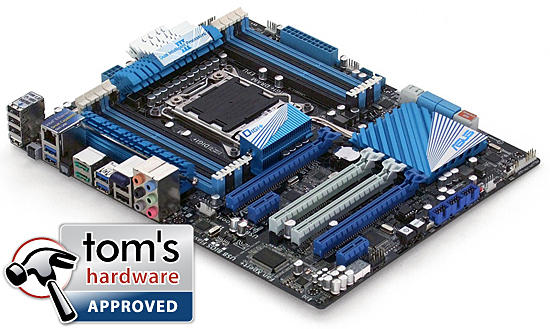Seven $260-$320 X79 Express Motherboards, Reviewed
With 40 lanes of PCIe 3.0 connectivity to host all of our high-bandwidth devices, LGA 2011 certainly qualifies as a premium processor interface. Today we examine seven X79-based motherboards that offer high-end features at a more palatable price.
Which X79-Based Motherboard Is Right For You?
For as little as $305, Asus' P9X79 Pro provides the best overall performance and best memory overclocking of the boards tested today. Yet, that performance advantage is only 0.1% above the cheapest board in this round-up, Gigabyte’s X79-UD3.
If we were to consider the same cut-rate vendor's $250 price for the X79-UD3, we’d have to disqualify it from this $260-320 motherboard round-up. On the other hand, a $270 price at several of our preferred venders puts it back within this roundup's target price range. We asked Gigabyte about the price spread before placing its board in this price segment, and the company insisted that it's able to compete against higher-end products. If we split the difference and call it a $260 contender, its four-way SLI support would still make it a top value pick with hardcore gamers. Asus has more memory slots, more USB 3.0 ports, and a Bluetooth transceiver to offset its higher price and the loss of four-way SLI, however. So, anyone who can’t afford or simply doesn’t want four high-end graphics cards could find either of these two chief competitors offering similar value.
ASRock’s X79 Extreme6/GB, on the other hand, takes first place in overclocking, in spite of the fact that it was unable to overcome the bug that prevented our CPU from employing multiplier-based overclocking on most boards. We can instead look at the positive side of our overclocking experience, in that the X79 Extreme6/GB demonstrates exceptional base clock-based overclocking, which could make it the best choice for anyone running a Core i7-3820.
Availability of the X79 Extreme6/GB is currently a little awkward, since the only seller currently offering it has a poor customer service reputation. That same seller offers spectacular pricing, though. Unfortunately, we're not able to speculate how much this platform might cost when it reaches some of the other vendors we prefer. Again, we’re left using Gigabyte’s less expensive board as a point of comparison, and for $30 more, an X79 Extreme6/GB buyer gains two rear-panel USB 3.0 ports, loses four-way SLI support, and gets a very nice audio/network card that won’t even fit if you use three-way CrossFire or SLI. While some builders will be willing to sacrifice graphics in order to retain the Creative Core3D secondary audio and Broadcom secondary Ethernet functionality, we’d instead hope to see ASRock's X79 Extreme6/GB available at a more trusted etailer, selling at a lower price, and without the combo card vs 3-way graphics debate.
Honors for the best on-board features go to ECS’ X79R-AX, with its four-way graphics card support (matching Gigabyte), Bluetooth module (matching Asus), and integrated Wi-Fi adapter (trumping both). If we buy it from a vendor we trust, the X79R-AX’s $310 Web price is actually cheaper than what we pay for Asus’ P9X79 Pro. Yet, its lack of three- or four-way SLI bridges, along with a USB 3.0 port that can’t be used when a fourth card is installed, hint at a product designed with more ambition than forethought. Also employing Intel’s unsanctioned SAS controller, the X79R-AX is probably the gutsiest board, and we'd like to see it revised to offer front-panel USB 3.0 connectivity and four-card support simultaneously.
Foxconn’s Quantumian-1 delivers on a good layout and super-stable voltage regulator, but UEFI limits prevent it from gaining notoriety as an overclocking champion. The added value of dual network controllers offsets its lack of four-way SLI support compared to Gigabyte’s X79-UD3, though the two are apparently targeting slightly different buyers with similar budgets. We have to reserve value awards for platforms with fully fleshed-out firmware, and this one's not quite there.
Intel’s $280 DX79SI does most things well, but nothing spectacularly. That’s a great way to keep loyal customers, but a tough way to pick them off from the competition. We like its high efficiency and “Back to BIOS” button. However, mediocre overclocking and pricing garnered lukewarm reactions.
MSI tops our charts in efficiency, and nothing else. Its price fluctuates between $290 and $300, coming in at the upper range of where we think it belongs. Lacking the four-way graphics capability of Gigabyte’s X79-UD3 and the two network controllers on Foxconn’s Quantumian-1, the added value of its eight DIMM slots is offset by a front-panel USB 3.0 connector that blocks a third high-end graphics card from being installed. The inability to reduce Turbo Boost ratios prevented us from getting the best overclock possible.


We conclude this review with a tie between Asus and Gigabyte, depending on the features that matter most to you. While the differences between the customers targeted by these two products are too vast for us to single one out for our “Recommended Buy” award, our “Approved” award can go to multiple products. Today, that’s how we recognize the value leadership both companies share within the $260-320 price segment.
Current page: Which X79-Based Motherboard Is Right For You?
Prev Page OverclockingStay On the Cutting Edge: Get the Tom's Hardware Newsletter
Get Tom's Hardware's best news and in-depth reviews, straight to your inbox.
-
Crashman jprahmanSo when will we see results with a C2?It's going to take around a month to prepare another roundup...so I guess good news comes with bad news, sorry.Reply -
Crashman amuffinfoxconn boards are pretty good.They've been making decent enthusiast boards on-and-off for a while.Reply -
morne Quick coment on looks only (I know its specs that count not looks but oh well)Reply
ASRock X79 Extreme6/GB - very nice all black looks better than gigabytes atempt
Asus P9X79 Pro - new baby blue they use on all the boards... not for me
ECS X79R-AX - looks like my old pentium 2 board with the white slots
Foxconn Quantumian-1 - i like i like gives a feeling of the ROG ASUS boards
Gigabyte X79-UD3 - rip of from the ASRock X79 Extreme6/GB (lol) plus the southbridge heatsink looks old fasion and ugly.
Intel DX79SI - now this board for me looks good actualy more than good looks the best :) must be the scull lol
MSI X79A-GD65 8D - also very nice love the blue + Black.
If you have one of the boards and i insulted it, wasnt the intention, just my view of the board>
-
stingstang My only question is.. Why do you guys need 6 freaking $1050 processors? Good golly gosh!Reply -
ubercake Great descriptive article.Reply
One thing I'm not sure of is the acceptance and actual usage of eSATA. While practical at some level, is anyone actually using this MB feature or is this one of those things the MB producers can skip out on like parallel and serial ports? I'm not sure enthusiasts are all that into using their eSATA ports?
Personally, I think this is one of those money saving opportunities MB producers should consider. -
geekapproved After the X58 anal pounding, you would be a moron to buy a X79. It's life is predicted to be even shorter than X58.Reply -
morne Actualy i agree with you ubercake, i have never used my E-sata, and with usb 3.0 out doubt anyone still uses E-sata if they have before.Reply
